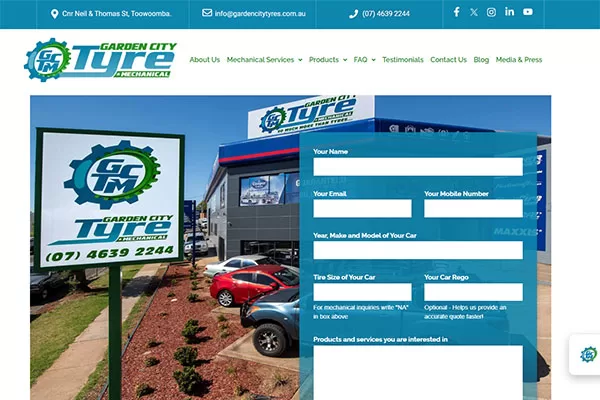Thank you Garden City Tyres and Neils for the opportunity to look after your website. What we have done for Garden City Tyres is to refresh and update the look and feel of the existing design bringing the overall website up to date. We have refreshed the back end too assuring only well maintained and up to date plugins are in use replacing legacy items which cause issues down the road.
If you are in Toowoomba and in need of tyres or mechanical services, please check out garden city tyres.
Check out the live website
Refreshing your business website is a crucial step in maintaining its relevance, optimizing user experience, and ensuring its alignment with current industry standards and consumer expectations. Various factors contribute to the need for a website refresh, and recognizing these indicators can help you determine the optimal time to embark on this essential undertaking.
- Outdated Design: If your website’s design appears outdated or no longer reflects your brand’s identity, it may be time for a refresh. Modern, visually appealing designs can significantly enhance user engagement and convey a sense of professionalism and credibility, thereby fostering a positive perception of your brand.
- Poor User Experience: Websites that offer a poor user experience, such as slow loading times, complex navigation, or non-responsive layouts, can drive potential customers away. A website refresh can optimize user experience by incorporating intuitive navigation, responsive design, and fast loading speeds, thereby enhancing customer satisfaction and retention.
- Mobile Responsiveness: With the increasing reliance on mobile devices for internet browsing, ensuring that your website is mobile-responsive is paramount. A website refresh can incorporate mobile-friendly design elements, ensuring seamless access and navigation across various devices, thereby expanding your reach and accessibility to a broader audience.
- Search Engine Optimization (SEO): If your website is not optimized for search engines, it may struggle to rank prominently in search results, limiting its visibility to potential customers. A website refresh can incorporate SEO best practices, including relevant keywords, meta descriptions, and optimized content, enhancing your website’s visibility and driving organic traffic to your business.
- Content Relevance: If your website’s content is outdated, irrelevant, or lacks consistency, it can negatively impact your brand’s credibility and authority. A website refresh can involve updating content to reflect current industry trends, incorporating engaging visuals, and providing informative and valuable content that resonates with your target audience, thereby establishing your brand as a trusted industry resource.
- Integration of New Features: Integrating new features and functionalities that enhance user engagement and interaction can significantly improve your website’s overall performance. A website refresh can incorporate interactive elements, such as chatbots, social media integrations, and e-commerce capabilities, providing visitors with a seamless and immersive browsing experience that encourages active participation and facilitates conversions.
- Security Enhancements: With the prevalence of cybersecurity threats, ensuring that your website is secure and protected from potential vulnerabilities is paramount. A website refresh can involve implementing the latest security protocols, installing SSL certificates, and conducting regular security audits to safeguard sensitive information and build customer trust in your brand’s commitment to data privacy and protection.
- Competitive Edge: To maintain a competitive edge in your industry, it is essential to stay abreast of your competitors’ digital strategies and online presence. A website refresh can enable you to incorporate innovative features, cutting-edge design elements, and industry best practices, positioning your brand as a frontrunner in your market and fostering a distinct competitive advantage that sets you apart from your peers.
- Evolving Business Goals: As your business evolves and diversifies its offerings, your website should reflect these changes and communicate your updated value proposition effectively. A website refresh can align your digital presence with your evolving business goals, highlighting new products or services, showcasing recent achievements, and reinforcing your brand’s commitment to innovation and customer satisfaction.
- Feedback and Analytics: Monitoring user feedback and analyzing website analytics can provide valuable insights into areas that require improvement and refinement. A website refresh can incorporate data-driven enhancements based on user feedback and analytical insights, enabling you to make informed decisions that optimize your website’s performance and resonate with your target audience’s preferences and expectations.
By recognizing the significance of these key indicators and proactively addressing them through a timely website refresh, you can ensure that your business website remains a powerful and effective tool for engaging with your target audience, fostering brand credibility, and driving sustainable growth and success in the digital marketplace.
What People Also Ask
What is a website rebuild?
A website rebuild refers to the comprehensive overhaul and reconstruction of an existing website to improve its design, functionality, user experience, and overall performance. Unlike minor updates or cosmetic changes, a website rebuild involves a complete reevaluation and redevelopment of the website’s structure, content, and features, often with the aim of modernizing the site, enhancing its usability, and aligning it with current industry standards and best practices.
During a website rebuild, every aspect of the existing website is thoroughly reassessed, including its design elements, user interface, navigation, content, and underlying technology. The process typically involves the following key components:
- Redesigned User Interface: The website’s user interface (UI) is revamped to improve visual appeal, enhance user engagement, and ensure seamless navigation. This may involve creating a more modern and visually appealing layout, optimizing the use of white space, and implementing intuitive navigation elements that facilitate easy access to information and services.
- Enhanced User Experience (UX): The user experience (UX) is a critical focus during a website rebuild, as the goal is to create an intuitive and user-friendly browsing experience that encourages visitors to explore the site further and engage with its content. This often involves improving site speed, implementing responsive design for mobile devices, and simplifying the user journey to facilitate seamless interactions and conversions.
- Content Optimization: Content plays a crucial role in conveying your brand’s message and value proposition to your target audience. During a website rebuild, the content is reviewed, updated, and optimized to ensure relevance, accuracy, and alignment with current SEO best practices. This may include rewriting existing content, incorporating new keywords, and enhancing multimedia elements to create a more engaging and informative user experience.
- Updated Technology and Functionality: Outdated technology can hinder a website’s performance and impact its security. A website rebuild involves upgrading the underlying technology stack, integrating the latest web development frameworks, and implementing advanced features and functionalities that enhance the site’s performance, security, and scalability. This may include incorporating new plugins, optimizing databases, and ensuring compliance with web standards and accessibility guidelines.
- SEO and Analytics Integration: Search engine optimization (SEO) and analytics play a vital role in driving website visibility and performance. During a website rebuild, SEO best practices are implemented to enhance the site’s search engine rankings, improve organic traffic, and increase online visibility. Additionally, analytics tools are integrated to track user behavior, monitor site performance, and gather valuable insights that inform future optimizations and strategic decisions.
- Brand Consistency and Messaging: A website rebuild presents an opportunity to strengthen brand consistency and messaging, ensuring that the website’s design, content, and overall communication align with your brand’s identity, values, and objectives. This may involve refining the brand’s visual elements, updating the tone and messaging to resonate with the target audience, and reinforcing the brand’s unique selling proposition throughout the website.
- Security and Compliance: Website security is a critical consideration in the digital age, given the prevalence of cybersecurity threats and data breaches. During a website rebuild, security protocols are reinforced, and measures are implemented to safeguard sensitive data, protect against potential vulnerabilities, and ensure compliance with industry-specific regulations and data protection laws.
By undergoing a comprehensive website rebuild, businesses can revitalize their online presence, enhance user engagement, and stay competitive in the ever-evolving digital landscape. This strategic initiative not only improves the overall performance and functionality of the website but also reinforces the brand’s credibility, fosters customer trust, and positions the business for sustained growth and success in the digital marketplace.
What is the difference between rebuild and redesign a website?
While the terms “rebuild” and “redesign” are often used interchangeably in the context of website development, they entail distinct processes and objectives that address different aspects of a website’s overall improvement. Understanding the nuances between these two approaches is crucial for determining the most suitable course of action based on your specific website requirements and objectives.
Website Rebuild:
A website rebuild involves a comprehensive reconstruction of the existing website, focusing on enhancing its functionality, performance, and underlying technology. The primary goal of a website rebuild is to overhaul the website’s infrastructure, often incorporating advanced technology and modern coding practices to improve its speed, security, and scalability. During a website rebuild, the entire site structure may be reevaluated, and the following aspects are typically addressed:
- Upgrading the underlying technology stack to the latest versions and frameworks.
- Enhancing website security and implementing advanced data protection measures.
- Improving website speed and performance through optimized coding and database management.
- Incorporating new features and functionalities that enhance user experience and engagement.
- Ensuring compliance with the latest web standards and accessibility guidelines.
- Retaining the existing content while optimizing it for improved search engine visibility.
Website Redesign:
On the other hand, a website redesign primarily focuses on enhancing the visual aesthetics, user interface, and user experience of the website. While a website redesign may involve certain aspects of a website rebuild, its main objective is to revamp the website’s appearance and improve its overall appeal to visitors. During a website redesign, the following aspects are typically addressed:
- Revamping the website’s visual elements, including layout, color scheme, and typography.
- Enhancing user experience through improved navigation and intuitive user interface design.
- Updating the website’s imagery, multimedia content, and visual branding elements.
- Simplifying the user journey and optimizing the conversion funnel for improved engagement.
- Incorporating responsive design to ensure seamless accessibility across various devices.
In essence, a website rebuild focuses on enhancing the website’s underlying infrastructure, performance, and functionality, while a website redesign emphasizes improving the website’s visual appeal, user interface, and user experience. Depending on the specific needs and objectives of your website, you may opt for either a website rebuild or a website redesign, or a combination of both, to ensure that your online presence remains modern, engaging, and aligned with your brand’s goals and user expectations.


